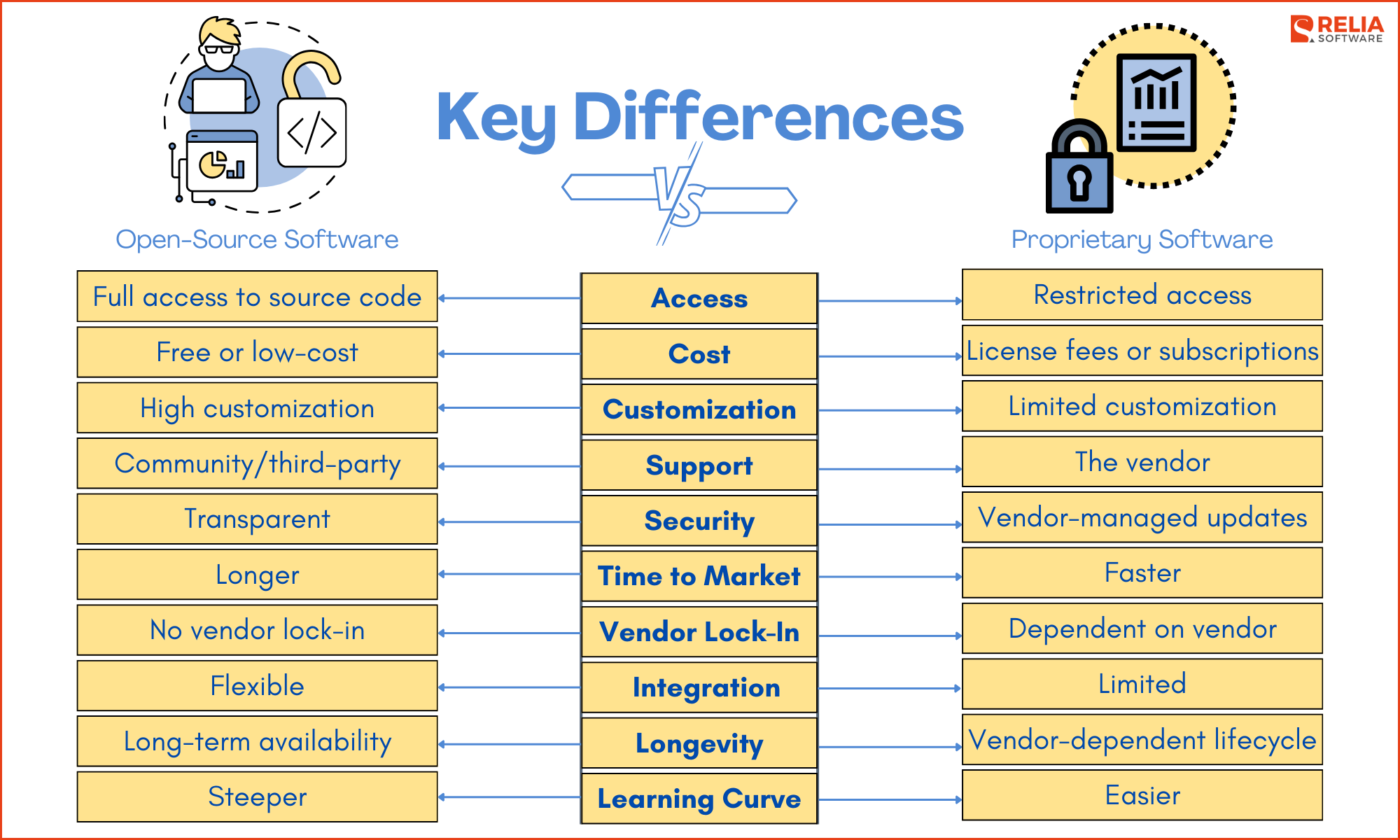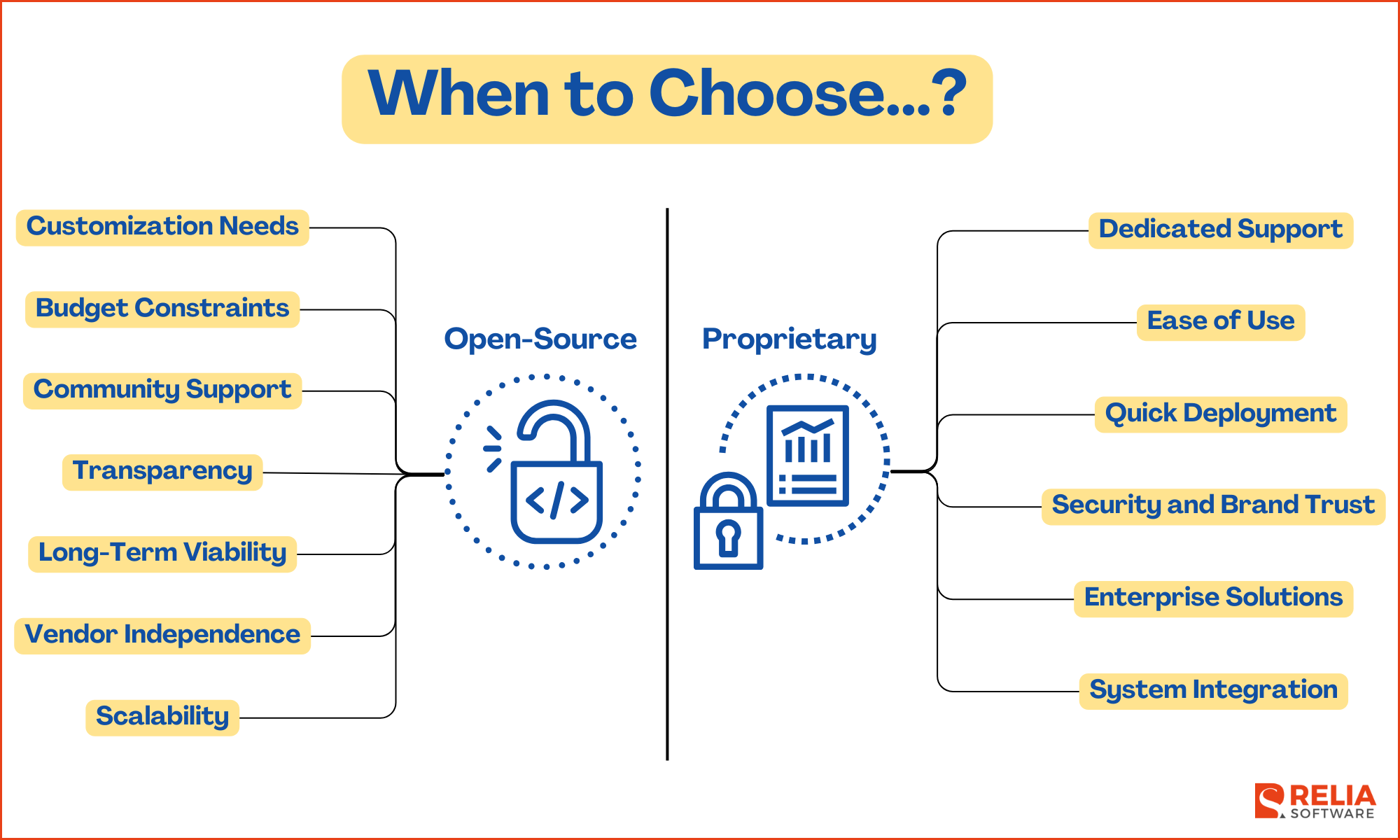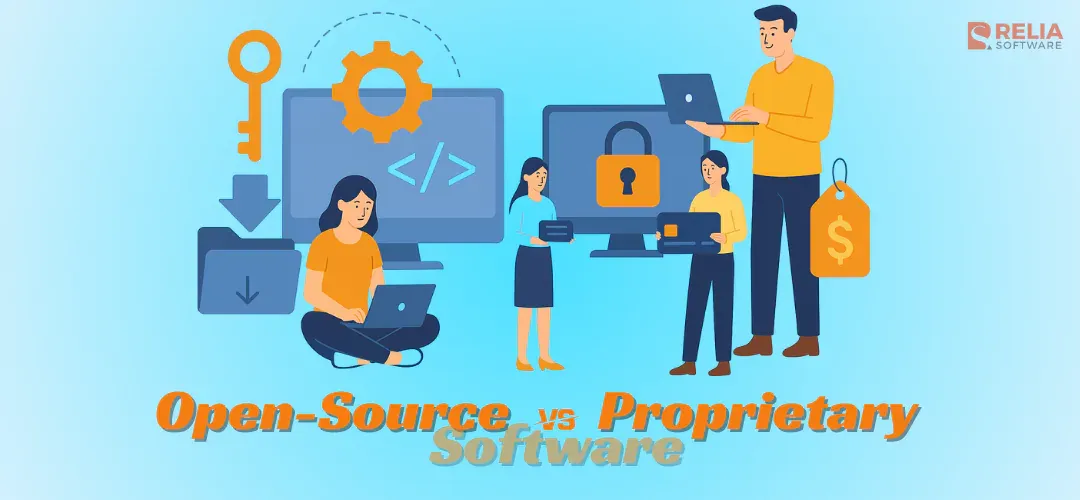Before starting your software project, one of the first things you'll have to decide is whether to use open-source or private software for your business. These two models are very different in how they handle development, cost, and adaptability. Specifically, open-source software is often free and encourages collaboration, while proprietary software provides a more centralized, packaged solution.
But which one will work best for you? This guide will explain the main differences between open-source and private software so that you can make the right choice.
>> Read more: Off-the-Shelf Software vs Custom Software: Which to Choose?
Key Differences Between Open-Source and Proprietary Software
Access to Source Code
-
Open-Source:
Users have full access to the source code, which means they can view, modify, and even distribute the software as they see fit. This level of control lets individuals and organizations customize the software to meet specific needs, adding new features, fixing bugs, or optimizing performance. Its transparency also fosters community support and collaboration.
Popular examples include Linux, Apache, and MySQL, where global communities contribute to the software’s development and improvement.
-
Proprietary:
The source code for proprietary software is private. The developer or vendor owns the codebase, so users cannot change or inspect it. This can make the software less flexible because the only ways to customize it are through official updates or options given by the vendor.
Some examples of proprietary software are Microsoft Windows and Adobe Photoshop, where the company sets the rules for users.
Cost Structure
-
Open-Source:
Open-source software is usually free. This makes it a good choice for individuals, small businesses, and even large organizations looking to reduce software costs. However, there can be hidden costs, such as internal support, custom development, or third-party services for adding advanced functionality or support.
-
Proprietary:
Proprietary software often operates on a paid model. Users need to purchase licenses or subscriptions, which often include support, updates, and maintenance services. Although the initial cost is higher, users get structured customer service and official support from the vendor, which makes managing software internally easier.
Support and Maintenance
-
Open-Source:
Support for open-source software mainly comes from the community. Many open-source projects have large, active communities that contribute to forums, documentation, and bug fixes. For enterprise-level support, users can turn to third-party service providers, but this comes at an additional cost. Open-source support can be highly specialized but may lack the formal structure of proprietary support systems.
-
Proprietary:
Proprietary software generally comes with dedicated support provided by the vendor. This support is often tiered, with different levels available depending on the pricing model. Users benefit from regular updates, patches, and fixes directly from the software creator, ensuring that they are using the most secure and up-to-date version of the product.
Security
-
Open-Source:
Open-source software benefits from the concept of “many eyes.” Since the code is available to everyone, security vulnerabilities can be identified and fixed by a global community of developers. The open nature means that users can inspect the software’s security measures firsthand. However, the responsibility for applying security patches often falls on the user or organization using the software, which can be a challenge for non-technical users.
-
Proprietary:
In proprietary software, the source code is hidden from users, making it harder for external parties to identify potential security risks. The responsibility for identifying and patching vulnerabilities lies solely with the vendor, who typically releases security updates regularly. However, due to its widespread use, proprietary software can become an attractive target for large-scale attacks.
>> You may be interested in:
- Top 14 Best Data Security Software For Your Businesses
- Top 7 Web App Security Testing Tools For Developers
- What is Security Testing in Software Testing? Types & Examples
Flexibility and Customization
-
Open-Source:
One of the biggest advantages of open-source software is the freedom to modify and extend the software as needed. Developers can build custom solutions on top of the existing code, enabling businesses to tailor software to their unique requirements. For example, companies like Google and Facebook have built massive infrastructures using customized versions of open-source software.
-
Proprietary:
Customization in proprietary software is typically limited to the options and settings provided by the vendor. More advanced customization often requires additional features or modules that may incur extra costs. For businesses with highly specialized needs, this can lead to limitations in terms of what can be achieved with the software.
Licensing and Legal Considerations
-
Open-Source:
Open-source software comes with licenses that let users freely use, modify, and share the software. However, there are different types of open-source licenses with varying rules. For instance, licenses like the GPL require that any modified versions also remain open-source, while others like MIT or Apache don’t have such requirements. It’s important for businesses to understand these licenses to avoid any potential legal issues.
-
Proprietary:
Proprietary software is licensed under strict terms, often limiting how the software can be used, shared, or modified. Users must comply with the terms and conditions set by the vendor, and breaking them can result in penalties. The legal considerations are more straightforward, but the restrictive nature of proprietary licenses can limit flexibility for users.
Longevity and Vendor Lock-In
-
Open-Source:
Open-source software’s longevity depends on its community or a supporting foundation. Even if the original developers abandon a project, the code remains available for anyone to continue development. This reduces the risk of vendor lock-in, as users can switch providers or self-support without losing access to the software.
-
Proprietary:
Proprietary software is entirely dependent on the vendor. If the vendor decides to discontinue the product or stop providing support, users are left with limited options. This increases the risk of vendor lock-in, where switching to another solution becomes costly or difficult, especially if the software is heavily integrated into the business's operations.

Here's a comparison table summarizing the difference between open-source and proprietary software:
|
Aspect |
Open-Source |
Proprietary |
|
Source Code Access |
Fully accessible, modifiable. |
Closed, vendor-controlled. |
|
Cost |
Free, potential support/customization costs. |
Requires license/subscription fees. |
|
Support |
Community or paid third-party support. |
Vendor-provided, often tiered. |
|
Security |
Publicly reviewed, user-applied patches. |
Vendor-managed, target for large-scale attacks. |
|
Customization |
Highly customizable. |
Limited, vendor-controlled options. |
|
Ecosystem |
Strong community and ecosystem of tools and resources. |
May have a limited ecosystem. |
|
Licensing |
Open-source licenses (e.g., GPL, MIT). |
Strict, limited user rights. |
|
Longevity |
Community-driven, code always available. |
Vendor-dependent, risk of lock-in. |
|
Integration |
Flexible, easily integrates with other tools. |
Limited to vendor-approved integrations. |
|
Learning Curve |
Steeper for non-technical users. |
Easier due to vendor support and documentation. |
|
Time to Market |
Longer due to customization and setup. |
Faster with pre-packaged solutions. |
|
Brand Reputation |
Varies by project, typically less brand-focused. |
Established brands, high market trust. |
When to Choose Open-Source Software?
- Customization Needs: If your project needs a high level of customization, open-source software lets you modify the code to fit your specific requirements.
- Budget Constraints: For individuals or businesses, especially startups, looking to reduce software costs, open-source can be a budget-friendly solution.
- Community Support: Open-source is great if you want access to a large, active community for support, innovation, and ongoing contributions.
- Transparency: If understanding how the software works is important to you, open-source provides full access to the source code, offering complete transparency.
- Long-Term Viability: Open-source software is more resilient to changes in the market or vendor support, as the community can continue to maintain it even if the original developers stop.
- Vendor Independence: If you want to avoid relying on a specific vendor and maintain control over your software, open-source offers greater autonomy.
- Scalability: Open-source software provides the flexibility to grow and adapt without the restrictions often imposed by vendors, making it ideal for long-term scalability.
When to Choose Proprietary Software?
- Dedicated Support: If you need structured, professional support, especially in a corporate setting, proprietary software offers reliable and timely assistance.
- Ease of Use: For teams without technical expertise to manage or modify open-source software, proprietary software provides a user-friendly interface that’s easier to set up and use.
- Quick Deployment: If you need a ready-made solution that can be implemented quickly, proprietary software comes with pre-packaged features that speed up time to market.
- Security and Brand Trust: For businesses that prioritize security and rely on trusted brands, proprietary software ensures regular updates and comes with a well-established reputation.
- Enterprise Solutions: Large organizations that need advanced features, scalability, and seamless integrations often benefit from the full support and robustness of proprietary software.
- System Integration: Proprietary software may offer specific APIs and tools that simplify integration with other proprietary systems, making it easier to connect with existing technologies.

FAQs
-
How do open-source software developers and companies generate revenue if the software itself is free? Open-source software developers and companies generate revenue through various models, including consulting services, enterprise support, professional services, and merchandise. Some also rely on donations or crowdfunding.
-
How do open-source and proprietary software models affect a company’s innovation potential in the long term? Open-source promotes innovation by allowing companies to freely customize and build upon existing code, while proprietary software limits flexibility but may provide more stable, vendor-backed advancements.
-
What are the hidden costs associated with maintaining open-source software compared to proprietary software? Hidden costs for open-source include internal support, custom development, and integration, whereas proprietary software often includes these in the licensing fee.
-
In what scenarios can proprietary software outperform open-source alternatives in terms of scalability and security? Proprietary software excels in industries with strict security requirements, such as finance and healthcare, where certified support and guaranteed scalability are critical.
-
How can businesses ensure legal compliance when using open-source software in mission-critical projects? Businesses should carefully review open-source licenses, consult legal experts, and track third-party code to avoid violations and ensure compliance.
-
Can open-source software be just as secure as proprietary software, and what practices should businesses adopt to enhance security? Yes, open-source can be secure if businesses actively manage updates, apply patches, and audit code. Security practices like regular audits and using reputable community-supported projects are key.
>> You may consider:
- Detailed Breakdown For App Development Cost in 2024
- 8 Software Development Life Cycle (SDLC) Methodologies
- Unlock the Potential of Automation in Software Development
Final Thoughts
The difference between open-source and proprietary software lies in their approach to development, distribution, and control. Open-source software is developed and maintained by a community, while proprietary software is controlled by a single entity. This distinction leads to differences in terms of cost, customization, support, and security.
Ultimately, the best choice between open-source and proprietary software depends on your specific needs and priorities. If you want control and customization without vendor constraints, open-source offers a world of flexibility, creative freedom, and community-driven innovation. Contrastly, proprietary software provides polished, ready-made solutions with dedicated support and streamlined security, ideal for businesses that prioritize stability, simplicity, and fast implementation.
Carefully weighing these factors will help you determine which software model aligns best with your operational goals.
>>> Follow and Contact Relia Software for more information!
- Mobile App Development
- development

